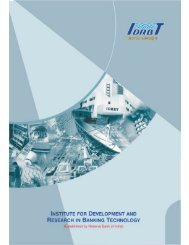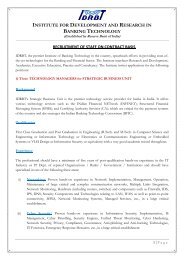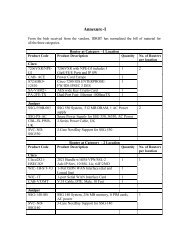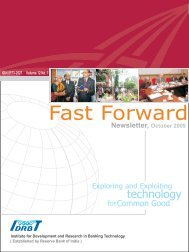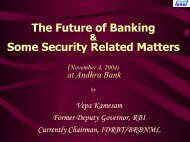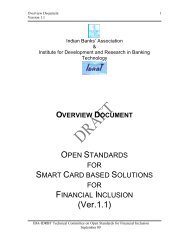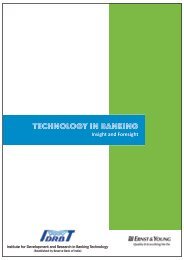SFMS Bank Application Interface Specifications Document ... - IDRBT
SFMS Bank Application Interface Specifications Document ... - IDRBT
SFMS Bank Application Interface Specifications Document ... - IDRBT
You also want an ePaper? Increase the reach of your titles
YUMPU automatically turns print PDFs into web optimized ePapers that Google loves.
<strong>Document</strong> Number:<br />
Copy Number:<br />
INSTITUTE FOR DEVELOPMENT AND RESEARCH IN<br />
BANKING TECHNOLOGY<br />
HYDERABAD<br />
Structured Financial Messaging System<br />
<strong>SFMS</strong> <strong>Bank</strong> <strong>Application</strong> <strong>Interface</strong> <strong>Specifications</strong><br />
Version: 3.0<br />
Prepared By<br />
Deccan Park,<br />
#1 Software Layout, Madhapur, Hyderabad-500 081<br />
September 2004<br />
Confidential and controlled document.<br />
Unauthorised access or copying is prohibited.
<strong>SFMS</strong> <strong>Bank</strong> <strong>Application</strong> <strong>Interface</strong> <strong>Specifications</strong> Version 3.0<br />
DOCUMENT RELEASE NOTICE<br />
No.: - 3.0<br />
Client: Institute for Development & Research in <strong>Bank</strong>ing Technology, Hyderabad.<br />
Project: Structured Financial Messaging System (<strong>SFMS</strong>)<br />
<strong>Document</strong> details: <strong>SFMS</strong> <strong>Bank</strong> <strong>Application</strong> <strong>Interface</strong> <strong>Specifications</strong>, Version 3.0<br />
Name Version No. Description<br />
<strong>SFMS</strong> <strong>Bank</strong> <strong>Application</strong><br />
<strong>Interface</strong> <strong>Specifications</strong><br />
PF3020<br />
3.0 <strong>SFMS</strong> <strong>Interface</strong> with External <strong>Bank</strong><br />
<strong>Application</strong>s<br />
Revision details:<br />
Action taken Preceding<br />
(add/del/chg Page No.<br />
)<br />
New<br />
Page No.<br />
Revision<br />
Description<br />
Change Register serial numbers covered:<br />
The documents or revised pages are subject to document control.<br />
Please keep them up-to-date using the release notices from the distributor of the document.<br />
These are confidential documents. Unauthorized access or copying is prohibited.<br />
Approved by:<br />
Authorized by:<br />
Date:<br />
Date:<br />
Confidential<br />
Uncontrolled when Printed<br />
Page i
<strong>SFMS</strong> <strong>Bank</strong> <strong>Application</strong> <strong>Interface</strong> specifications Version 3.0<br />
TABLE OF CONTENTS<br />
CHAPTER 1 – INTRODUCTION.................................................................................. 1<br />
1.1 BACKGROUND...................................................................................................... 1<br />
1.2 DEFINITIONS, ACRONYMS, ABBREVIATIONS........................................................ 1<br />
1.3 ORGANISATION OF THE DOCUMENT ..................................................................... 2<br />
CHAPTER 2 – BANKAPI ARCHITECTURE.............................................................. 4<br />
2.1 <strong>SFMS</strong> BANK APPLICATION INTERFACE ............................................................... 4<br />
2.2 MESSAGES FLOW ................................................................................................. 5<br />
2.3 PRE-REQUISITES FOR BANKAPI ........................................................................... 6<br />
2.4 SOFTWARE REQUIREMENTS ................................................................................. 6<br />
2.5 HARDWARE REQUIREMENTS................................................................................ 6<br />
CHAPTER 3 – BANKAPI MESSAGE STRUCTURES ............................................... 7<br />
3.1 USER MESSAGE.................................................................................................... 7<br />
3.2 ACKNOWLEDGEMENT MESSAGE ........................................................................ 10<br />
3.3 NON-DELIVERY WARNING MESSAGE................................................................. 11<br />
3.4 DELIVERY NOTIFICATION MESSAGE .................................................................. 12<br />
3.5 OPEN NOTIFICATION.......................................................................................... 12<br />
3.6 BANKAPI RESPONSE MESSAGE........................................................................ 13<br />
CHAPTER 4 – BANKAPI USAGE WITH EXAMPLES ........................................... 14<br />
4.1 REGISTER EXTERNAL BANK APPLICATION ........................................................ 14<br />
4.2 SET-UP BANK API CLIENT AT EXTERNAL BANK APPLICATION ......................... 14<br />
4.3 START BANK API SERVER AT <strong>SFMS</strong> OFFLINE/ONLINE..................................... 15<br />
4.4 EXTERNAL APPLICATIONS MESSAGE PROCESSING ............................................ 15<br />
4.5 BANKAPI CLIENT INTERFACE THROUGH COMMAND LINE................................. 16<br />
4.6 BANKAPI CLIENT INTERFACE THROUGH PROGRAM METHOD............................ 17<br />
4.7 OVERVIEW OF <strong>SFMS</strong> BANKAPI USAGE ............................................................ 17<br />
CHAPTER 5 – LIST OF EXCEPTIONS AND LIMITATIONS ............................... 19<br />
5.1 LIST OF EXCEPTIONS.......................................................................................... 19<br />
5.2 LIMITATIONS...................................................................................................... 20<br />
APPENDIX A – DIGITAL SIGN AND VERIFICATION ......................................... 21<br />
APPENDIX B – SAMPLE PROGRAM TO CALL BANKAPI CLIENT................. 23<br />
Confidential<br />
Uncontrolled when Printed<br />
Page ii
<strong>SFMS</strong> <strong>Bank</strong> <strong>Application</strong> <strong>Interface</strong> specifications Version 3.0<br />
1.1 Background<br />
CHAPTER 1 – INTRODUCTION<br />
The <strong>SFMS</strong> system provides a solution for financial message communication across the<br />
Indian Financial Network (INFINET). The system enables exchange of messages in a<br />
highly secured environment. A message structure in <strong>SFMS</strong> (Structured Financial<br />
Messaging Solution) has been developed to take care of all kinds of Financial<br />
Transactions involved in Indian <strong>Bank</strong>ing System. The message structure is an adoption of<br />
an international standard SWIFT with minor modifications to take care of the additional<br />
messages required for Indian banking needs. The solution will enable the <strong>Bank</strong>s to carry<br />
out Inter-<strong>Bank</strong>/Inter-Branch transactions.<br />
With the Financial Network (INFINET) and a messaging format (<strong>SFMS</strong>) in place, it is<br />
envisaged that the <strong>Bank</strong>s will carry out Inter-bank and Intra <strong>Bank</strong> transactions<br />
automatically. In order to meet the requirements of Inter-bank and Intra bank<br />
transactions, we need to have an interface between <strong>SFMS</strong> and External <strong>Application</strong>s.<br />
This document provides the <strong>SFMS</strong>-External <strong>Application</strong>s interface <strong>Specifications</strong>, along<br />
with the details and functioning of the <strong>SFMS</strong>-External <strong>Application</strong>s Integration.<br />
<strong>SFMS</strong> API is the application interface for External <strong>Bank</strong> <strong>Application</strong>s to send and receive<br />
messages. This is a part of the <strong>SFMS</strong> Online / Offline Server software. The document<br />
provides details about the interface Architecture, Message formats and about the interface<br />
examples.<br />
The intended audiences of this document are:<br />
• <strong>Interface</strong> Developers of <strong>Bank</strong>s<br />
• <strong>Bank</strong>ing application Vendors<br />
1.2 Definitions, Acronyms, Abbreviations<br />
API<br />
<strong>Bank</strong>API<br />
CA<br />
CCA<br />
<strong>IDRBT</strong><br />
IFSC<br />
INFINET<br />
LAN<br />
PDE<br />
<strong>Application</strong> Program <strong>Interface</strong><br />
<strong>Bank</strong> <strong>Application</strong> Program <strong>Interface</strong><br />
Certifying Authority<br />
Controller of Certifying Authorities<br />
Institute for development and Research in <strong>Bank</strong>ing Technology<br />
Indian Financial System Code<br />
INdian FINancial NETwork.<br />
Local Area Network<br />
Possible Duplicate Emission<br />
Confidential<br />
Uncontrolled when Printed<br />
Page 1 of 24
<strong>SFMS</strong> <strong>Bank</strong> <strong>Application</strong> <strong>Interface</strong> specifications Version 3.0<br />
PDM<br />
RA<br />
RTGS<br />
<strong>SFMS</strong><br />
SWIFT<br />
TCP/IP<br />
TCS<br />
SMAC<br />
UMAC<br />
UNAK<br />
Possible Duplicate Message<br />
Registration Authority<br />
Real Time Gross Settlement<br />
Structured Financial Messaging System.<br />
This includes the Branch, Gateway and HUB nodes and the<br />
communication links between them.<br />
Society for World wide Inter-bank Financial Telecommunication<br />
Transmission Control Protocol / Internet Protocol<br />
Tata Consultancy Services<br />
This is the MAC generated with node server certificate<br />
This is the MAC generated with Authorizer’s signature<br />
This is the User NAK and is generated when the UMAC verification fails<br />
at the receiving branch.<br />
1.3 Organisation of the document<br />
The <strong>Bank</strong>API <strong>Specifications</strong> document is organised into the following chapters<br />
including this introduction Chapter:<br />
Chapter 2<br />
Chapter 3<br />
Chapter 4<br />
Chapter 5<br />
Appendix-A<br />
<strong>Bank</strong>API Architecture<br />
This chapter provides information about the <strong>Bank</strong>API Architecture,<br />
message flow, Hardware / Software requirements and pre-requites if<br />
any.<br />
<strong>Bank</strong>API Message Structures<br />
This chapter provides details about the message structures and<br />
provides examples.<br />
<strong>Bank</strong>API Usage with examples.<br />
This chapter explains about <strong>Bank</strong>API Server and usage of <strong>Bank</strong>API<br />
client.<br />
Exceptions and Limitations<br />
This chapter provides a list of <strong>Bank</strong>API Exceptions and Limitations<br />
in Usage.<br />
Digital Signing and Verification<br />
This Appendix provides information about the standards used in<br />
generation of UMAC.<br />
Confidential<br />
Uncontrolled when Printed<br />
Page 2 of 24
<strong>SFMS</strong> <strong>Bank</strong> <strong>Application</strong> <strong>Interface</strong> specifications Version 3.0<br />
Appendix-B<br />
Sample file to call <strong>Bank</strong>API Client<br />
This Appendix provides a sample program for calling <strong>Bank</strong>API<br />
client method.<br />
Confidential<br />
Uncontrolled when Printed<br />
Page 3 of 24
<strong>SFMS</strong> <strong>Bank</strong> <strong>Application</strong> <strong>Interface</strong> specifications Version 3.0<br />
2.1 <strong>SFMS</strong> <strong>Bank</strong> <strong>Application</strong> <strong>Interface</strong><br />
CHAPTER 2 – BANKAPI ARCHITECTURE<br />
The context diagram for the <strong>SFMS</strong> – <strong>Bank</strong>API solution is depicted below.<br />
<strong>Bank</strong>API Messages<br />
<strong>SFMS</strong><br />
<strong>SFMS</strong><br />
GW<br />
GW<br />
and<br />
and<br />
HUB<br />
HUB<br />
<strong>SFMS</strong> On-line /<br />
Offline with<br />
<strong>Bank</strong>API Server<br />
<strong>SFMS</strong> On-Line /<br />
Offline with<br />
<strong>Bank</strong>API Server<br />
<strong>Bank</strong> API - Client<br />
<strong>Bank</strong>API Client<br />
<strong>SFMS</strong> architecture primarily consists of the HUB, the <strong>Bank</strong> Gateway sites and the<br />
Branch sites connected to one another in a well-defined hierarchy. The HUB and<br />
the <strong>Bank</strong> Gateway sites are connected via VSAT communication links / leased<br />
lines. The <strong>Bank</strong> Gateways and the Branch Severs can be connected via shared /<br />
dedicated leased lines or Dial Up lines depending on proximity and the volume of<br />
traffic.<br />
In the above architecture, the messages are created from <strong>SFMS</strong> On-line / Offline<br />
clients. In general <strong>Bank</strong>s use different <strong>Bank</strong> applications for internal purposes.<br />
But, the <strong>Bank</strong> external application generated messages have to be sent to<br />
destination branches. For sending messages to destination branches, there should<br />
be a carrier to carry messages to destination. For supporting the above condition,<br />
<strong>SFMS</strong> has provided a secured messages interface module, which is known as the<br />
<strong>Bank</strong>API <strong>Interface</strong>.<br />
The <strong>SFMS</strong> <strong>Bank</strong> API has the following components:<br />
<strong>Bank</strong>API Server<br />
Confidential<br />
Uncontrolled when Printed<br />
Page 4 of 24
<strong>SFMS</strong> <strong>Bank</strong> <strong>Application</strong> <strong>Interface</strong> specifications Version 3.0<br />
The main function of the <strong>Bank</strong>API Server is to send and receive messages for<br />
requests from <strong>Bank</strong>API Client. The <strong>Bank</strong>API Server continuously runs as a<br />
demon process and waits to serve <strong>Bank</strong>API client requests.<br />
‣ <strong>Bank</strong>API Server validates incoming messages and sends response message<br />
to <strong>Bank</strong>API Client.<br />
‣ <strong>Bank</strong>API server validates user signature with Block 4 content, after<br />
successful validation, the message is processed.<br />
‣ <strong>Bank</strong>API Server sends set of messages to <strong>Bank</strong>API client on request.<br />
The message formats are discussed in the subsequent chapter.<br />
<strong>Bank</strong>API Client<br />
The <strong>Bank</strong>API client methods / programs are provided to External <strong>Application</strong><br />
interface vendor to call <strong>Bank</strong>API Server for purpose of sending and receiving<br />
messages.<br />
The functions available with <strong>Bank</strong>API client are:<br />
‣ Send message using file<br />
‣ Send message as a string<br />
‣ Receive messages as a string<br />
Some of the main activities to be carried out for using <strong>SFMS</strong> – <strong>Bank</strong>API are:<br />
‣ For processing of External <strong>Application</strong> messages, the external application<br />
identification has to be registered with <strong>SFMS</strong> at Online / Offline with unique<br />
<strong>Bank</strong> <strong>Application</strong> ID.<br />
‣ Setup <strong>Bank</strong>API Client as per the instructions provided in subsequent chapters.<br />
‣ Develop interface with <strong>SFMS</strong> <strong>Bank</strong>-API client and External application<br />
‣ For the purpose of sending and receiving messages from <strong>SFMS</strong> Online/<br />
Offline Server, Start <strong>Bank</strong>API Process at <strong>SFMS</strong> Online-Offline Server<br />
‣ Send and receive messages from <strong>SFMS</strong>-<strong>Bank</strong>API server using <strong>SFMS</strong><br />
<strong>Bank</strong>API Client.<br />
2.2 Messages Flow<br />
This section explains the detailed message flow from <strong>SFMS</strong> <strong>Bank</strong>API Server to<br />
External applications.<br />
Outgoing Message Flow<br />
‣ External <strong>Application</strong> creates the message in <strong>SFMS</strong> bank application format<br />
explained in subsequent sections.<br />
Confidential<br />
Uncontrolled when Printed<br />
Page 5 of 24
<strong>SFMS</strong> <strong>Bank</strong> <strong>Application</strong> <strong>Interface</strong> specifications Version 3.0<br />
‣ External application invokes <strong>SFMS</strong> <strong>Bank</strong>API Client with arguments having<br />
message as string or file. This is explained in <strong>Application</strong> Usage Section. Only<br />
one message can be sent at a time from the <strong>Bank</strong> API client to the <strong>Bank</strong> API<br />
server.<br />
‣ <strong>SFMS</strong> <strong>Bank</strong>API Server process running at <strong>SFMS</strong> Offline / Online server validates<br />
message and populates the data into <strong>SFMS</strong> Offline / Online Server on successful<br />
validation and also sends corresponding response message. The <strong>SFMS</strong> response<br />
message structure is explained in subsequent sections.<br />
‣ During the validation of the message, system verifies for the User Signature<br />
(UMAC).<br />
‣ If a message is not signed, then that message will be forced to be in “PENDING<br />
AUTHORIZATION” state. The user needs to authorize the message at <strong>SFMS</strong><br />
online / offline server manually (using <strong>SFMS</strong> <strong>Application</strong>).<br />
‣ If the message is signed, on successful verification of UMAC the message will be<br />
kept in ‘TO BE SENT” state in <strong>SFMS</strong>. If the verification fails, <strong>SFMS</strong> API returns<br />
the error code to the external application.<br />
2.2.1 Incoming Message Flow<br />
‣ External application invokes <strong>SFMS</strong> <strong>Bank</strong>API Client with receive option.<br />
‣ <strong>SFMS</strong> <strong>Bank</strong>API Server verifies External application request and sends the<br />
messages as a string.<br />
‣ Incoming messages are sent by the <strong>Bank</strong> API server to the client in chunks of ten<br />
each.<br />
‣ Incoming messages are returned in the form of a string with a delimiter $@$.<br />
2.3 Pre-requisites for <strong>Bank</strong>API<br />
‣ Ensure that <strong>SFMS</strong> V 3.0 or subsequent version is installed.<br />
‣ Ensure that Java2 runtime environment with RMI Support is available at External<br />
<strong>Application</strong><br />
2.4 Software Requirements<br />
Software Requirements at<br />
External <strong>Application</strong><br />
Java2 runtime environment<br />
with RMI Support<br />
Software Requirements at Offline/ Online<br />
Server<br />
No additional software required<br />
2.5 Hardware Requirements<br />
No separate Hardware is required for <strong>Bank</strong>API Server. <strong>SFMS</strong> online / offline Server<br />
can be used for <strong>Bank</strong>API Service.<br />
Confidential<br />
Uncontrolled when Printed<br />
Page 6 of 24
<strong>SFMS</strong> <strong>Bank</strong> <strong>Application</strong> <strong>Interface</strong> specifications Version 3.0<br />
3.1 User Message<br />
CHAPTER 3 – BANKAPI MESSAGE STRUCTURES<br />
The following fields are required for the <strong>Bank</strong> application in order to generate a valid<br />
<strong>SFMS</strong> message.<br />
Inde<br />
x<br />
Mandatory/<br />
Optional<br />
Field Name<br />
1. M Block A Begin<br />
Identifier<br />
2. M Sender <strong>Bank</strong><br />
application<br />
identifier<br />
3. M Message<br />
Identifier<br />
4. M Input/Output<br />
Identifier<br />
5. M Message Type 3 Alpha<br />
Numeric<br />
6. M Sub Message 3 Alpha<br />
Type<br />
Numeric<br />
7. M Sender IFSC 11 Alpha<br />
Numeric<br />
8. M Receiver IFSC 11 Alpha<br />
Numeric<br />
9. M Delivery<br />
Notification Flag<br />
10. M Open<br />
Notification Flag<br />
11. M Non-delivery<br />
warning flag<br />
Field<br />
Length<br />
Data<br />
Type<br />
Description<br />
3 Char Block A begin Identifier. This<br />
should be {A:<br />
3 Alpha Uniquely identifies the <strong>Bank</strong><br />
Numeric application.<br />
This is the identifier with which<br />
<strong>Bank</strong> application is registered at<br />
the branch server.<br />
3 Alpha <strong>Application</strong> Identifier<br />
Numeric F01- User to User<br />
1 Char IO Identifier<br />
O-Output<br />
I-Input<br />
INFINET message type<br />
INFINET Sub message type. If<br />
Sub Message Type is blank,<br />
then fill with XXX.<br />
IFSC code of the Sender (IFSC<br />
code to which the bank<br />
application is registered.)<br />
IFSC code of the receiver<br />
1 Number Users to specify whether<br />
delivery notification is required<br />
for the message.<br />
1 – YES<br />
2 – NO<br />
1 Number Users to specify whether open<br />
notification is required for the<br />
message.<br />
1 – YES<br />
2 – NO<br />
1 Number Flag to inform the user whether<br />
the non-delivery warning<br />
message is required or not. The<br />
possible values are: 1 – Yes<br />
2 – No<br />
12. M Obsolescence<br />
Period<br />
The default value for nondelivery<br />
warning flag is ‘2’.<br />
3 Number Users to specify the period after<br />
which a non-delivery warning is<br />
to be sent to the sender,<br />
applicable only if non-delivery<br />
Confidential<br />
Uncontrolled when Printed<br />
Page 7 of 24
<strong>SFMS</strong> <strong>Bank</strong> <strong>Application</strong> <strong>Interface</strong> specifications Version 3.0<br />
13. M MUR (Message<br />
User Reference)<br />
14. M Possible<br />
Duplicate<br />
Emission Flag<br />
16 Alpha<br />
Numeric<br />
15. M Service Identifier 3 Alpha<br />
Numeric<br />
warning flag is specified.<br />
If Non-delivery warning flag is<br />
2, then this value should be set<br />
to ‘000’.<br />
If Non-delivery warning flag is<br />
1, then obsolescence value<br />
should be greater than or equal<br />
to 002.<br />
Range of the values for this<br />
field can be between 002 to<br />
999.<br />
This is represented in absolute<br />
number of units. Each unit is<br />
internally interpreted as equal to<br />
5 minutes.<br />
For example Obsolescence<br />
period of 003 units is equivalent<br />
of 15 minutes.<br />
<strong>Bank</strong> <strong>Application</strong> uses this field<br />
for identifying the message. If it<br />
is less than 16 then<br />
concatenated with X.<br />
1 Number Flag to indicate possible<br />
duplicate emission<br />
1 – YES<br />
2 – NO<br />
Destination <strong>Bank</strong> <strong>Application</strong><br />
identifier.<br />
If not applicable, it should be<br />
defaulted to XXX.<br />
16. M Originating date 8 Number Date on which the message was<br />
created at <strong>Bank</strong> application –<br />
(YYYYMMDD)<br />
17. M Originating time 4 Number Time on which the message<br />
was created at <strong>Bank</strong> application<br />
–(HHMM)<br />
18.<br />
19. M Testing and<br />
Training flag<br />
20. M Sequence<br />
Number<br />
1 Number Flag to indicate test and training<br />
message.<br />
1 – YES<br />
2 – NO<br />
9 Alpha<br />
Numeric<br />
Unique sequence number<br />
generation by the external<br />
application for the identification<br />
of the message in external<br />
application system. System<br />
messages for the user messages<br />
generated by external<br />
applications will carry this<br />
Confidential<br />
Uncontrolled when Printed<br />
Page 8 of 24
<strong>SFMS</strong> <strong>Bank</strong> <strong>Application</strong> <strong>Interface</strong> specifications Version 3.0<br />
21. M Filler 9 Alpha<br />
Numeric<br />
22. M UTR (Unique 16 Alpha<br />
Transaction<br />
Numeric<br />
Reference)<br />
sequence number. <strong>SFMS</strong> API<br />
rejects the message if there is<br />
no sequence number.<br />
Ex: If sequence number is 5<br />
then user should send as<br />
‘000000005’<br />
Filler for future use and default<br />
value is XXXXXXXXX.<br />
Unique Transaction Reference<br />
Generated for RTGS. Host<br />
applications should default it to<br />
XXXXXXXXXXXXXXXX<br />
23. M Priority Flag 2 Number This Priority flag is used for<br />
routing the messages in RTGS<br />
messages. For Host applications<br />
the default value is 99<br />
24. M Block A End<br />
Identifier<br />
25. M Block4 Begin<br />
Identifier<br />
26. M Block 4 Alpha<br />
Numeric<br />
27. M Block End<br />
Identifier for<br />
Block 4<br />
28. O Block5A Begin<br />
Identifier<br />
29. O Block 5A Alpha<br />
Numeric<br />
30. O Block5A End<br />
Identifier<br />
1 Char Block End identifier. This<br />
should be }<br />
3 Alpha This block4 begin identifier<br />
Numeric should be<br />
{4:<br />
Text block of the message.<br />
Length of the message cannot<br />
exceed 10 KB.<br />
2 Char Block End identifier should be -<br />
}<br />
6 Char It the <strong>Bank</strong> <strong>Application</strong> can<br />
generate the UMAC then this<br />
should be {UMAC:<br />
If the <strong>Bank</strong> <strong>Application</strong> does<br />
not have the capability to<br />
prepare the signature, this field<br />
can be left blank.<br />
Authorizer Signature. This is an<br />
optional field, which can be<br />
filled by <strong>Bank</strong> applications with<br />
signature prepared in PKCS7<br />
standard on Block4<br />
Information.<br />
If the <strong>Bank</strong> <strong>Application</strong> does<br />
not have the capability to<br />
prepare the signature, this field<br />
can be left blank. If this field is<br />
blank the messages will be<br />
forced to be in “PENDING<br />
AUTHORIZATION” state in<br />
<strong>SFMS</strong> Offline/Branch Server.<br />
1 Char If the <strong>Bank</strong> <strong>Application</strong> can<br />
generate the UMAC then this<br />
should be }<br />
If the <strong>Bank</strong> <strong>Application</strong> does<br />
not have the capability to<br />
prepare the signature, this field<br />
can be left blank.<br />
Confidential<br />
Uncontrolled when Printed<br />
Page 9 of 24
<strong>SFMS</strong> <strong>Bank</strong> <strong>Application</strong> <strong>Interface</strong> specifications Version 3.0<br />
Note: For straight through processing of messages Block 5A is mandatory.<br />
An example for the incoming message structure to the <strong>SFMS</strong> branch server from <strong>Bank</strong><br />
application is shown below<br />
{A:<br />
Block A begin Identifier<br />
B09<br />
<strong>Bank</strong> <strong>Application</strong> Identifier<br />
F01<br />
Message Identifier<br />
O Input/output Identifier ( either I or O)<br />
100 Message type<br />
XXX<br />
Sub Message type ( For IFN 298C01, this<br />
field should be C01, for IFN100<br />
Message, this field should be XXX)<br />
SBIN0001001<br />
Sender IFSC Code<br />
SBIN0001002<br />
End receiver IFSC Code<br />
1 Delivery notification flag<br />
1 Open Notification flag<br />
2 Non-delivery Warning flag<br />
005 Obsolescence Period<br />
abcdefgh12345678<br />
Message User Reference (MUR)<br />
2 Possible Duplicate flag<br />
XXX<br />
Service Identifier<br />
20030909 Originating date<br />
1020 Originating time<br />
2 Testing and training flag<br />
000012345 Sequence Number<br />
XXXXXXXXXX<br />
Filler<br />
XXXXXXXXXXXXXXXX<br />
Unique Transaction Reference.<br />
99 Priority Flag<br />
} Block A end Identifier<br />
{4: Block 4 Begin Identifier<br />
:20:TT/320<br />
Block 4 text message format<br />
:32A:20030909INR100,<br />
-} Block 4 End Identifier<br />
{UMAC:<br />
Block 5A Begin Identifier<br />
<br />
User Signature for Authorisation<br />
} Block 5A End Identifier<br />
3.2 Acknowledgement Message<br />
Index<br />
Mandato<br />
ry /<br />
Field Name<br />
Field<br />
Length<br />
Data<br />
Type<br />
Description<br />
Confidential<br />
Uncontrolled when Printed<br />
Page 10 of 24
<strong>SFMS</strong> <strong>Bank</strong> <strong>Application</strong> <strong>Interface</strong> specifications Version 3.0<br />
Optional<br />
1 M Block Identifier 3 Char Block Identifier<br />
2 M <strong>Bank</strong> application Identifier 3 Alpha <strong>Bank</strong> <strong>Application</strong> Identifier<br />
Numeric<br />
3 M Message Identifier 3 Alpha<br />
Numeric<br />
Message Identifier<br />
F20 – Acknowledgement<br />
Message<br />
1 Char Input/Output Identifier<br />
I – Input<br />
4 M Input/Output<br />
Identifier<br />
5 M Sequence number 9 Number External <strong>Application</strong><br />
Sequence Number for which<br />
this acknowledgement is<br />
intended.<br />
7 M Sender IFSC 11 Alpha<br />
Numeric<br />
IFSC code of Originating<br />
<strong>SFMS</strong> branch.<br />
8 M Date and Time 12 Number Date and Time on which<br />
message is acknowledged<br />
9 M Block End Identifier 1 Char Block End Identifier<br />
{A:B09F20O000001000SBIN0001001200103031325}<br />
{A:<br />
Block Identifier<br />
B09<br />
<strong>Bank</strong> <strong>Application</strong> Identifier<br />
F20<br />
Acknowledgment message<br />
I<br />
Input/Output Identifier<br />
000001000 External <strong>Application</strong> Sequence Number<br />
SBIN0001001<br />
Originating IFSC<br />
200309091023 Date and time on which the sender <strong>SFMS</strong> Gateway<br />
acknowledges message<br />
} Block End Identifier<br />
3.3 Non-delivery Warning Message<br />
Index<br />
Manda<br />
tory/O<br />
ptional<br />
Field Name<br />
Field<br />
Length<br />
Field<br />
Type<br />
Description<br />
1 M Block Identifier 3 Char Block Identifier<br />
2 M <strong>Bank</strong> application Identifier 3 Char <strong>Bank</strong> <strong>Application</strong> Identifier<br />
3 M Message Identifier 3 Alpha<br />
Numeric<br />
Message Identifier<br />
F22 - Non-delivery Warning<br />
message<br />
4 M Input/Output<br />
Identifier<br />
1 Char Input/Output Identifier<br />
I – Input<br />
5 M Sequence number 9 Number External <strong>Application</strong><br />
Sequence Number .<br />
7 M Sender IFSC 11 Alpha<br />
Numeric<br />
IFSC code of Originating<br />
<strong>SFMS</strong> branch.<br />
8 M Date and Time 12 Numeric Date and Time at which nondelivery<br />
warning message is<br />
generated.<br />
9 M Block End Identifier 1 Char Block End Identifier<br />
Confidential<br />
Uncontrolled when Printed<br />
Page 11 of 24
<strong>SFMS</strong> <strong>Bank</strong> <strong>Application</strong> <strong>Interface</strong> specifications Version 3.0<br />
{A: B09F22I000001000SBIN000100200101012227}<br />
{A:<br />
Block Identifier<br />
B09<br />
<strong>Bank</strong> <strong>Application</strong> Identifier<br />
F22<br />
Non-delivery Warning Message<br />
I<br />
Input/Output Identifier<br />
000001000 Creation sequence number of the message<br />
SBIN000100<br />
Originating IFSC<br />
200101012227 Date and time on which non-delivery warning message is<br />
generated.<br />
} Block End Identifier<br />
3.4 Delivery Notification Message<br />
Index Mandatory/Option Field Name Field Field Description<br />
al<br />
Length Type<br />
1 M Block Identifier 3 Char Block Identifier<br />
2 M <strong>Bank</strong> application 3 Alpha <strong>Bank</strong> <strong>Application</strong> Identifier<br />
Identifier<br />
Numeric<br />
3 M Message Identifier 3 Alpha<br />
Numeric<br />
Message Identifier<br />
F23 - Delivery Notification<br />
message<br />
4 M Input/Output<br />
Identifier<br />
1 Char Input/Output Identifier<br />
I – Input<br />
5 M Sequence number 9 Number External <strong>Application</strong><br />
sequence number<br />
7 M Sender IFSC 11 Alpha<br />
Numeric<br />
IFSC code of Originating<br />
<strong>SFMS</strong> branch.<br />
8 M Date and Time 12 Number Date and time on which the<br />
message is delivered.<br />
9 M Block End Identifier 1 Char Block End Identifier<br />
{A: B09F23I000001000SBIN0001002000004000}<br />
{A:<br />
Block Identifier<br />
B09<br />
<strong>Bank</strong> <strong>Application</strong> Identifier<br />
F23<br />
Delivery Notification Message<br />
I<br />
Input/Output Identifier<br />
000001000 Creation sequence number of the message<br />
SBIN0000002<br />
IFSC code of Originating <strong>SFMS</strong> branch.<br />
200101081730 Date and time on which the message is<br />
delivered.<br />
} Block End Identifier<br />
3.5 Open Notification<br />
Index<br />
Mandatory/Option<br />
al<br />
Field Name<br />
Field<br />
Length<br />
Field<br />
Type<br />
Description<br />
Confidential<br />
Uncontrolled when Printed<br />
Page 12 of 24
<strong>SFMS</strong> <strong>Bank</strong> <strong>Application</strong> <strong>Interface</strong> specifications Version 3.0<br />
1 M Block Identifier 3 Char Block Identifier<br />
2 M <strong>Bank</strong> application 3 Alpha <strong>Bank</strong> <strong>Application</strong> Identifier<br />
Identifier<br />
Numeric<br />
3 M Message Identifier 3 Alpha<br />
Numeric<br />
Message Identifier<br />
F24 - Open Notification<br />
message<br />
4 M Input/Output<br />
Identifier<br />
1 Char Input/Output Identifier<br />
I – Input<br />
5 M Sequence number 9 Number External <strong>Application</strong><br />
sequence number<br />
6. M Sender IFSC 11 Alpha<br />
Numeric<br />
IFSC code of Originating<br />
<strong>SFMS</strong> branch.<br />
7 M Date and Time 12 Number Date and time on which the<br />
message is opened at<br />
destination.<br />
8 M Block End Identifier 1 Char Block End Identifier<br />
{A:B09F24O000001000SBIN000100200101081730}<br />
{A:<br />
Block Identifier<br />
B09<br />
<strong>Bank</strong> <strong>Application</strong> Identifier<br />
F24<br />
Open Notification Message<br />
I<br />
Input/Output Identifier<br />
000001000 Creation sequence number of the message<br />
200103032323 Date and time on which message is opened.<br />
SBIN000100<br />
IFSC code of Originating <strong>SFMS</strong> branch.<br />
} Block End Identifier<br />
3.6 <strong>Bank</strong>API Response Message<br />
Index Mandatory/Option Field Name Field Field Description<br />
al<br />
Length Type<br />
1 M Block Identifier 1 Char Block Identifier Always {<br />
2 M Return Indicator 1 Char P=Passed<br />
F=Failed<br />
3 O Reason Code 10 Alpha<br />
Numeric<br />
Reason code for Failure.<br />
Host applications should<br />
have the mapping screen for<br />
mapping these reason codes<br />
to reason descriptions.<br />
4 M Block End Identifier 1 Char Block End Identifier.<br />
Always }<br />
{FIMRT020021}<br />
{ Block Identifier<br />
F<br />
Failed<br />
IMRT020021 Failed due to the reason sender IFSC doesn’t exist in IIFSC<br />
directory. Reasons codes detailed in subsequent sections.<br />
} Block end identifier.<br />
Confidential<br />
Uncontrolled when Printed<br />
Page 13 of 24
<strong>SFMS</strong> <strong>Bank</strong> <strong>Application</strong> <strong>Interface</strong> specifications Version 3.0<br />
CHAPTER 4 – BANKAPI USAGE WITH EXAMPLES<br />
This chapter gives a detailed explanation about External application registration, <strong>SFMS</strong><br />
<strong>Bank</strong>API startup and shutdown and usage of <strong>Bank</strong>API Client.<br />
4.1 Register External <strong>Bank</strong> <strong>Application</strong><br />
First step in the <strong>Bank</strong>API process is the registration of an external application at<br />
<strong>SFMS</strong> Offline/ Online Server. The registration process is as follows:<br />
Click Message Routing Register <strong>Bank</strong> <strong>Application</strong> to access the Register<br />
External <strong>Application</strong> screen. Enter unique External <strong>Application</strong> Id, description and<br />
password to register an External <strong>Application</strong>.<br />
The Register screen has the following entries.<br />
Items<br />
Description<br />
External <strong>Application</strong> Id A Text Box to enter a valid External <strong>Application</strong> Id.<br />
External <strong>Application</strong> Description A Text Box to enter description for an External<br />
<strong>Application</strong><br />
Password<br />
A Text Box to enter a Password.<br />
Click Save button to register the external application.<br />
Click Reset button to reset values.<br />
For more information on <strong>Bank</strong> <strong>Application</strong> registration details refer to the Offline<br />
and Online User Manuals.<br />
4.2 Set-up <strong>Bank</strong> API Client at External <strong>Bank</strong> <strong>Application</strong><br />
For sending and receiving messages successfully using <strong>Bank</strong> API Server, the<br />
following steps need to be carried out at <strong>SFMS</strong> Client Server:<br />
‣<br />
‣<br />
‣ At <strong>SFMS</strong> <strong>Bank</strong>API client, create a folder by name ‘sfmsbr’ and sub folder by<br />
name ‘bankapi’<br />
‣ Copy <strong>Bank</strong>APIClient.class, <strong>Bank</strong>APIImpl_Stub.class, and<br />
<strong>Bank</strong>API<strong>Interface</strong>.class from C:\<strong>SFMS</strong>\jakarta-tomcat-<br />
3.2.3\webapps\ROOT\WEB-INF\classes\sfmsbr\bankapi folder of <strong>SFMS</strong> Online<br />
/Offline Server to the bankapi folder at the External <strong>Bank</strong> <strong>Application</strong>.<br />
‣ Set CLASSPATH environment variable to include the class files<br />
<strong>Bank</strong>APIClient.class, <strong>Bank</strong>APIImpl_Stub.class, and <strong>Bank</strong>API<strong>Interface</strong>.class<br />
Confidential<br />
Uncontrolled when Printed<br />
Page 14 of 24
<strong>SFMS</strong> <strong>Bank</strong> <strong>Application</strong> <strong>Interface</strong> specifications Version 3.0<br />
‣ Copy <strong>Bank</strong>APIConfig.properties from C:\<strong>SFMS</strong>\jakarta-tomcat-<br />
3.2.3\webapps\ROOT\WEB-INF\classes\sfmsbr\coms\core\utils folder of <strong>SFMS</strong><br />
Online / Offline server to bankapi folder of External <strong>Bank</strong>API client server.<br />
4.3 Start <strong>Bank</strong> API Server at <strong>SFMS</strong> Offline/Online<br />
The following steps are required for executing the <strong>Bank</strong> API Server:<br />
‣ The RMI Client will request for reference of component at the Online / Offline<br />
Server.<br />
‣ The Registry will send back the reference of component.<br />
‣ The client will invoke methods (send & receive) of the component<br />
After successful execution of <strong>Bank</strong> API server, follow the steps given below:<br />
‣ Click Start on your Windows desktop. Select Run.<br />
‣ Enter cmd. Click Ok.<br />
‣ At the command prompt type rmiregistry and press enter<br />
‣ Again Click Start on your Windows desktop. Select Run<br />
‣ Enter cmd. Click Ok.<br />
‣ At the command prompt type java sfmsbr.bankapi.<strong>Bank</strong>APIServer and press<br />
enter.<br />
Example : C:\>java sfmsbr.bankapi.<strong>Bank</strong>APIServer<br />
The message Server Started indicates successful execution of <strong>Bank</strong> API server.<br />
4.4 External <strong>Application</strong>s Message Processing<br />
External applications can send and receive messages by using the following methods:<br />
‣ Command line argument<br />
‣ <strong>SFMS</strong> <strong>Bank</strong>API program method.<br />
The details of the above process are explained in subsequent sections.<br />
Confidential<br />
Uncontrolled when Printed<br />
Page 15 of 24
<strong>SFMS</strong> <strong>Bank</strong> <strong>Application</strong> <strong>Interface</strong> specifications Version 3.0<br />
4.5 <strong>Bank</strong>API client <strong>Interface</strong> through Command Line<br />
<strong>Bank</strong>API File Send Option<br />
Using this option external applications can send messages as files.<br />
java sfmsbr.bankapi.<strong>Bank</strong>APIClient filesend filename.txt <br />
Example: C:\> java sfmsbr.bankapi.<strong>Bank</strong>APIClient filesend filename.txt <br />
Message Send option<br />
Using this option, external applications can send a message as a string.<br />
Example: C:\> java sfmsbr.bankapi.<strong>Bank</strong>APIClient msgsend <br />
Filename is an optional argument, if the user selects filename, then the status of the<br />
message will be written to file. Otherwise the status will be displayed on output<br />
device.<br />
Message receive option<br />
For receiving a message from <strong>SFMS</strong> <strong>Bank</strong>API server, the external application<br />
invokes <strong>Bank</strong>API from the command line arguments as<br />
java sfmsbr.bankapi.<strong>Bank</strong>APIClient receive <br />
<br />
Example: java sfmsbr.bankapi.<strong>Bank</strong>APIClient receive API BANKAPI<br />
IFSC0000001<br />
Filename is an optional argument, if the user selects filename, then the status of the<br />
message will be written to file. Otherwise the status will be displayed on output<br />
device.<br />
IFSC is the IFSC code of the Online/Offline server where the External <strong>Bank</strong><br />
<strong>Application</strong> has been registered.<br />
Confidential<br />
Uncontrolled when Printed<br />
Page 16 of 24
<strong>SFMS</strong> <strong>Bank</strong> <strong>Application</strong> <strong>Interface</strong> specifications Version 3.0<br />
4.6 <strong>Bank</strong>API client <strong>Interface</strong> through Program Method<br />
<strong>SFMS</strong> <strong>Bank</strong>API client can be called using <strong>SFMS</strong> <strong>Bank</strong>API Client program<br />
methods. The client method returns a string to the external application.<br />
The following methods are available for external programming interface:<br />
‣ executeRemoteProcess(java.lang.String[] args)<br />
• This method should be called from another program with the<br />
following arguments to send a message to <strong>SFMS</strong> <strong>Bank</strong>API Server.<br />
Parameters:<br />
String - should be either filesend or msgsend or receive<br />
String - if filesend input absolute path of file, if msgsend input content<br />
of the message, if receive External<strong>Application</strong>Id.<br />
String - Password.<br />
String - if receive IFSC.<br />
‣ getResponse()<br />
• This method returns the response message when a file is sent.<br />
‣ getReceivedMessages()<br />
• This method returns the string of received messages.<br />
For the sample program provided for developers, refer Appendix B.<br />
4.7 Overview of <strong>SFMS</strong> <strong>Bank</strong>API Usage<br />
S.No. Program Arguments Description<br />
1 <strong>Bank</strong>APIClient msgsend<br />
<br />
<br />
<br />
First argument “msgsend” indicates<br />
that the system is trying to send a<br />
message in the form of a string.<br />
Second argument is the string<br />
containing the actual message to be<br />
transmitted to <strong>SFMS</strong>. This method<br />
will return a string either in file or<br />
on the output device. The filename is<br />
an optional argument where the<br />
2. <strong>Bank</strong>APIClient Filesend<br />
<br />
<br />
incoming messages are to be saved.<br />
First argument “filesend” indicates<br />
that the system is trying to send a<br />
message in the form of a file.<br />
Second argument is the string<br />
containing the filename of the<br />
message to be transmitted to <strong>SFMS</strong>.<br />
This method will return a string<br />
either in file or on the output device.<br />
The filename is optional argument.<br />
Confidential<br />
Uncontrolled when Printed<br />
Page 17 of 24
<strong>SFMS</strong> <strong>Bank</strong> <strong>Application</strong> <strong>Interface</strong> specifications Version 3.0<br />
3. <strong>Bank</strong>APIClient Receive <br />
“receive” argument receives<br />
messages in the form of a string at<br />
that instance from <strong>SFMS</strong> and $@*<br />
as a delimiter with limit of maximum<br />
no. of ten messages .<br />
4. executeRemotePro<br />
cess (Arguments)<br />
msgsend<br />
<br />
<br />
Filesend<br />
<br />
Receive <br />
If there are no messages, the system<br />
gives status as ‘No Messages<br />
Received’.<br />
This method will return a string<br />
either in file or on the output device.<br />
The filename is an optional<br />
argument.<br />
This method is called from another<br />
program with required Arguments<br />
and responses will be received by<br />
calling the following methods:<br />
For file send / message Send:<br />
- getResponse()<br />
For message receive<br />
- getReceivedMessages()<br />
Note: Sample program provided at<br />
Appendix-B.<br />
Confidential<br />
Uncontrolled when Printed<br />
Page 18 of 24
<strong>SFMS</strong> <strong>Bank</strong> <strong>Application</strong> <strong>Interface</strong> specifications Version 3.0<br />
5.1 List of Exceptions<br />
CHAPTER 5 – List of Exceptions and Limitations<br />
The following are <strong>Bank</strong>API Error Messages and their corresponding descriptions<br />
S No Error Code and Description<br />
1. PBAPI000000=Message sent successfully<br />
2. FBAPI000001=Invalid Block-A Begin Identifier. (Prescribed format is {A:)<br />
3. FBAPI000002=Invalid Sender <strong>Bank</strong> <strong>Application</strong> identifier. (eg : APP)<br />
4. FBAPI000003=Invalid Message Identifier. (eg : F01)<br />
5. FBAPI000004=Invalid Input/Output identifier. (Always O)<br />
6. FBAPI000005=Invalid Message Type. (eg 100)<br />
7. FBAPI000006=Invalid Sub Message Type. (For IFN298C01, this field should be<br />
C01, for IFN100 message, this field should be XXX)<br />
8. FBAPI000007=Invalid Sender IFSC. (eg : CNRB0000001)<br />
9. FBAPI000008=Invalid Receiver IFSC. (eg : CNRB0000001)<br />
10. FBAPI000009=Invalid Delivery Notification Flag. (either 1 or 2)<br />
FBAPI000010=Invalid Open Notification Flag. (either 1 or 2)<br />
11. FBAPI000011=Invalid Obsolescence Period. (Range of values for this filed<br />
should be between 002 to 999)<br />
12. FBAPI000012=Invalid Message User Reference (eg: abcdefgh12345678)<br />
13. FBAPI000013=Invalid Possible Duplicate Emission Flag. (either 1 or 2)<br />
14. FBAPI000014=Invalid Receiving <strong>Bank</strong> <strong>Application</strong> Identifier (eg: TBA if<br />
present or XXX if not present)<br />
15. FBAPI000015=Invalid Originating Date.(Format should be YYYYMMDD)<br />
16. FBAPI000016=Invalid Originating Time.(Format should be HHMM)<br />
17. FBAPI000017=Invalid Delayed Message Flag.(Either 1 or 2)<br />
18. FBAPI000018=Invalid Testing & Training Flag. (Either 1 or 2)<br />
19. FBAPI000019=Invalid Sequence Number or duplicate sequence number. (eg :<br />
000000001)<br />
20. FBAPI000020=Invalid Filler. (default should be XXXXXXXXX)<br />
21. FBAPI000021=Invalid User Transaction Reference.(default should be<br />
XXXXXXXXXXXXXXXX)<br />
22. FBAPI000022=Invalid Priority Flag. (Default should be 00)<br />
23. FBAPI000023=Invalid Block-A End identifier. (should be })<br />
24. FBAPI000024=Invalid Block4 Begin identifier. (should be {4:)<br />
25. FBAPI000025=Invalid Block4. (Length of the message cannot exceed 10 KB)<br />
26. FBAPI000026=Invalid Block4 End identifier. (Block end identifier should be})<br />
27. FBAPI000027=Invalid Block5A Begin identifier.(Should be {UMAC:)<br />
28. FBAPI000028=Invalid Block5A.<br />
29. FBAPI000029=Invalid Block5A End identifier.(Should be })<br />
30. FBAPI000030=Sender & Receiver IFSC should not be same.<br />
31. FBAPI000031=Invalid Header Length<br />
32. FBAPI000100=Invalid UserId.<br />
33. FBAPI000101=Invalid Password<br />
34. FBAPI000102=Error in Deformatter.<br />
35. FBAPI000103=Error in Syntax Check.<br />
Confidential<br />
Uncontrolled when Printed<br />
Page 19 of 24
<strong>SFMS</strong> <strong>Bank</strong> <strong>Application</strong> <strong>Interface</strong> specifications Version 3.0<br />
36. FBAPI000104=Error in Conditional rules.<br />
37. FBAPI000105=Error in Check UMAC.<br />
5.2 Limitations<br />
‣ External <strong>Bank</strong> <strong>Application</strong>s can send one message at a time through <strong>Bank</strong>API.<br />
‣ External <strong>Bank</strong> <strong>Application</strong>s can receive a maximum of 10 messages at a time<br />
including User and system messages.<br />
‣ The <strong>SFMS</strong> <strong>Bank</strong>API Server and Client should be on the same Local area network.<br />
Confidential<br />
Uncontrolled when Printed<br />
Page 20 of 24
<strong>SFMS</strong> <strong>Bank</strong> <strong>Application</strong> <strong>Interface</strong> specifications Version 3.0<br />
Appendix A – Digital Sign and Verification<br />
For straight through processing of a message, <strong>Bank</strong>API requires Block 5A with UMAC<br />
information. This section provides information on message signing and algorithms<br />
required.<br />
SIGNATURE<br />
TCS uses PKCS#7 specifications for Digital signatures. This standard describes a general<br />
syntax for data that may have cryptography applied to it, such as digital signatures and<br />
digital envelopes. Even though PKCS#7 specification specifies syntax for Signed data,<br />
enveloped data, signed and enveloped data, encrypted data etc, only PKCS#7 Signed<br />
Data is used in <strong>SFMS</strong>. The PKCS#7 data structure is shown below.<br />
PKCS#7 (CONTENT INFO)<br />
Content Type<br />
Content<br />
Indicates the type of content. It is an object identifier,<br />
which means it is a unique string of integers assigned by<br />
the authority that defines the content type. The value set<br />
by TCS is 1.2.840.113549.1.7.2<br />
Content. It consists of Signed – data Content Type<br />
PKCS#7(SIGNED DATA )<br />
Version The syntax version number. It shall be 1<br />
DigestAlgorithms<br />
Collection of message-digest algorithm identifiers.<br />
ContentInfo<br />
The content that is signed. The Content Type value set by TCS is<br />
1.2.840.113549.1.7.1 and the Content is “NULL” (detached Signature)<br />
Set Of Certificates<br />
TCS sets the Signer Digital Certificate<br />
Set of CRLs<br />
This optional field is not used by TCS<br />
Stack of Signer Info<br />
algorithm ID<br />
Algorithm identifier<br />
Parameters<br />
Algorithm used to sign certificate. TCS<br />
use either SHA1 or MD5<br />
Should not be used.<br />
Signer Info<br />
Version The syntax version number. It shall be 1<br />
IssuerAndSerialNumber<br />
Specifies the signer's certificate<br />
algorithm ID<br />
Identifies the message-digest algorithm (and<br />
Any associated parameters) under which the content and<br />
Authenticated attributes (if present) are digested. TCS uses<br />
SHA1 or MD5 algorithm<br />
AuthenticatedAttributes<br />
Set of attributes that are signed<br />
(i.e., authenticated) by the signer. TCS sets the following<br />
attributes 1) A PKCS #9 content-type attribute having as its<br />
value the content type of the Content Info value being signed 2)<br />
A PKCS #9 message-digest attribute, having as its value the<br />
message digest of the content 3) The signing-time at which the<br />
signer performed the signing process.<br />
Confidential<br />
Uncontrolled when Printed<br />
Page 21 of 24
<strong>SFMS</strong> <strong>Bank</strong> <strong>Application</strong> <strong>Interface</strong> specifications Version 3.0<br />
digestEncryptionAlgorithm<br />
EncryptedDigest<br />
unauthenticatedAttributes<br />
Identifies the digest-encryption algorithm (and any associated<br />
parameters) under which the message digest and associated<br />
information are encrypted with the signer's private key. TCS<br />
uses “RSA Encryption” (1.2.840.113549.1.1.1)<br />
The result of encrypting the message digests and associated<br />
information with the signer's private key.<br />
Set of attributes that are not signed by the Signer. This optional<br />
field is not used by TCS<br />
Confidential<br />
Uncontrolled when Printed<br />
Page 22 of 24
<strong>SFMS</strong> <strong>Bank</strong> <strong>Application</strong> <strong>Interface</strong> specifications Version 3.0<br />
Appendix B – Sample Program to call <strong>Bank</strong>API client<br />
A sample Java Program to call <strong>Bank</strong>API server for sending and receiving of external<br />
application messages is shown below:<br />
package sfmsbr.bankapi;<br />
import sfmsbr.bankapi.<strong>Bank</strong>APIClient;<br />
public class Call<strong>Bank</strong>APIClient<br />
{<br />
public static void main(String[] args)<br />
{<br />
String[] arguments = new String[4];<br />
String response = "";<br />
<strong>Bank</strong>APIClient bankAPIClient = null;<br />
if(args[0].equalsIgnoreCase("filesend"))<br />
{<br />
try{<br />
//argument specifying FILE SEND process.<br />
arguments[0] = "filesend";<br />
//input file<br />
arguments[1] = "c:\\APITestMessage.txt";<br />
//password<br />
arguments[2] = "123456";<br />
//instantiating <strong>Bank</strong>APIClient object<br />
bankAPIClient = new <strong>Bank</strong>APIClient();<br />
//calling executeRemoteProcess method in <strong>Bank</strong>APIClient class.<br />
bankAPIClient.executeRemoteProcess(arguments);<br />
//response msg after executeRemoteProcess method<br />
response = bankAPIClient.getResponse();<br />
System.out.println("response for filesend = "+response);<br />
}catch(Exception e){}<br />
}<br />
else if(args[0].equalsIgnoreCase("msgsend"))<br />
{<br />
try{<br />
//argument specifying MESSAGE SEND process.<br />
arguments[0] = "msgsend";<br />
//input message<br />
arguments[1] =<br />
"{A:ABCF01O100XXXCNRB0000001CNRB0000002112005abcdefgh123456782APP2003092<br />
315352000000008XXXXXXXXXXXXXXXXXXXXXXXXXXX}{4:~:20:TRA-<br />
008~:32A:20040901INR200,~:50:DINESH~HYD~:59:/RAJA~HYD~-}";<br />
//password<br />
arguments[2] = "123456";<br />
//instantiating <strong>Bank</strong>APIClient object<br />
bankAPIClient = new <strong>Bank</strong>APIClient();<br />
//calling executeRemoteProcess method in <strong>Bank</strong>APIClient class.<br />
bankAPIClient.executeRemoteProcess(arguments);<br />
Confidential<br />
Uncontrolled when Printed<br />
Page 23 of 24
<strong>SFMS</strong> <strong>Bank</strong> <strong>Application</strong> <strong>Interface</strong> specifications Version 3.0<br />
}<br />
}<br />
//response message after executeRemoteProcess method<br />
response = bankAPIClient.getResponse();<br />
System.out.println("response for msgsend = "+response);<br />
}catch(Exception e){}<br />
}<br />
else if(args[0].equalsIgnoreCase("receive"))<br />
{<br />
try{<br />
//argument specifying MESSAGE RECEIVE process.<br />
arguments[0] = "receive";<br />
//External<strong>Application</strong>Registered at Receive side<br />
arguments[1] = "APP";<br />
//password<br />
arguments[2] = "123456";<br />
//IFSC Code at Receiving side.<br />
arguments[3] = "CNRB0000002";<br />
//instantiating <strong>Bank</strong>APIClient object<br />
bankAPIClient = new <strong>Bank</strong>APIClient();<br />
//calling executeRemoteProcess method in <strong>Bank</strong>APIClient class.<br />
bankAPIClient.executeRemoteProcess(arguments);<br />
//received messages after executeRemoteProcess method<br />
response = bankAPIClient.getReceivedMessages();<br />
System.out.println("response for Receive = "+response);<br />
}catch(Exception e){}<br />
}<br />
else<br />
{<br />
System.out.println("*****************Usage*****************");<br />
System.out.println("incorrect usage:Refer Follow <strong>Bank</strong>API client<br />
Usage");<br />
}<br />
Confidential<br />
Uncontrolled when Printed<br />
Page 24 of 24



